Young people from Lithuania and Latvia came together to rethink how we live online. Guided by media experts, NGO representatives, and facilitators from Langas į ateitį (part of SIC Lithuania), they created educational games, social media campaigns, and shared their vision for a healthier internet.
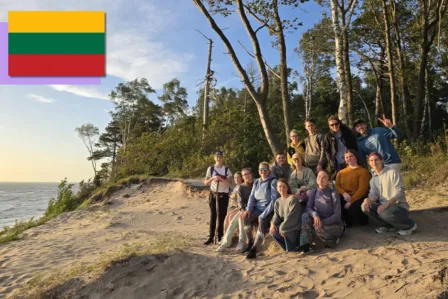
The camp left a very positive impression on the participants – some are already asking whether it will be held again next year. The positive experience was shaped not only by meaningful activities, but also by a consciously nurtured balance: some workshops took place on the beach, and after a full day, participants spent time in nature, surrounded by forest.
What are teenagers really doing online?
The camp kicked off by exploring what teenagers themselves brought to the table. Before arriving, each participant had completed a homework assignment: to reflect on their digital life – the words they use, the trends they follow, the tone they adopt.
One teenager from Lithuania opened up about how racist content still circulates in his friend group – and how deeply it affects them, especially when it comes from people close to him. The Latvian group introduced “tone indicators”: tools used to express emotional tone in writing and help reduce misunderstandings online.
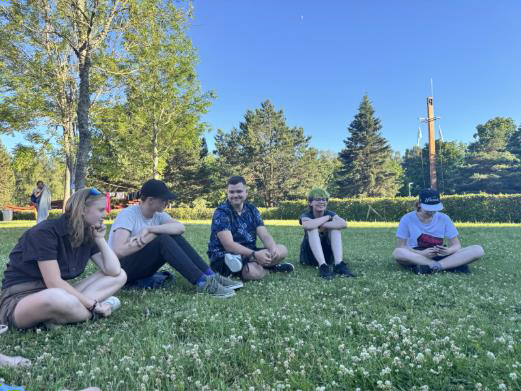
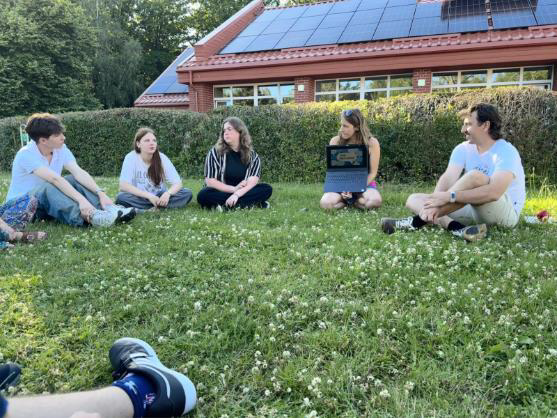
Homework presentations at the camp.
Creative sprint led by Arminas Varanauskas
Day two was dedicated to a full-day creative challenge led by youth media expert Arminas Varanauskas. Participants designed a fictional peer – a user persona – and explored a real digital issue, like misleading links. They then brainstormed solutions that could be implemented right away. Some teams developed social media campaigns, while others created toolkits and ideas for schools. One thing became clear: young people have more solutions than we often give them credit for.
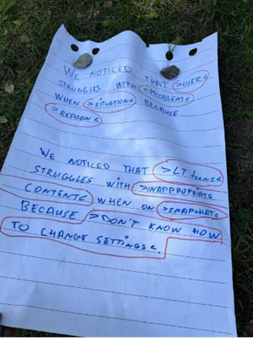
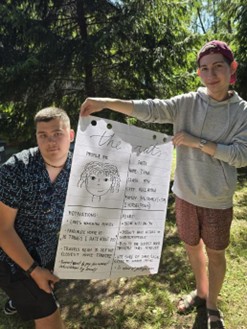
Creative sprint activities with Arminas Varanauskas.
Two teams, two creative tracks
Later on the same day, participants split into two working groups. One team focused on creating a Q&A resource about the digital world – covering everything from algorithms and screen time to how social media affects one’s behaviour and emotions. The second team collaborated with project leader Liudas Mikalkevičius to enhance an educational game he developed for schools – designed to teach students about safer internet habits, how to spot deepfakes, and how algorithms really work.
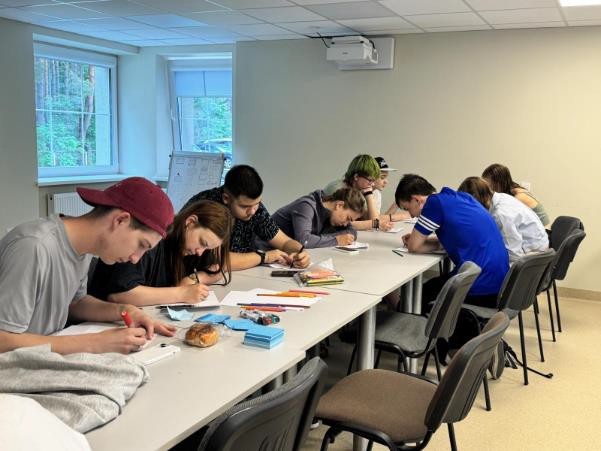
Talking about what usually gets left out
The day ended with a discussion session that led into a screening of the documentary Can’t Feel Nothing which explores the emotional toll of the digital age, by David Borenstein. The conversation was moderated by Dominyka Vaičiūnaitė, Draugiškas Internetas content creator.
Participants didn’t just reflect on how social media affected us in the past – they examined how it continues to shape lives today. Is it still worth having these conversations? Or are we too tired of talking about change that never really happens? Participants imagined what the world might look like in ten years if nothing changes – if we continue on the same path of endless scrolling and passive engagement.
The teenagers shared personal experiences of screen addiction, difficulty focusing, and the strange tension of social media being both a comfort and a source of stress.
They envisioned what their ideal social networks would look like – spaces with less pressure, more authenticity, and a true sense of community.
Langas į ateitį: art that speaks louder than words
One afternoon, a creative session was led by representative of Langas į ateitį Violeta Čiuplytė Bogdanovič. Together with the participants, everyone painted on t-shirts and stones, combining images and ideas about how the internet could become a safer, warmer space. It was one of those rare moments when words weren’t needed – everything the participants wanted to express came through in color and form.
This hands-on activity brought together three core elements of the camp: offline, face-to-face connection, open reflection on the challenges young people face online, and creative thinking toward a safer digital environment.
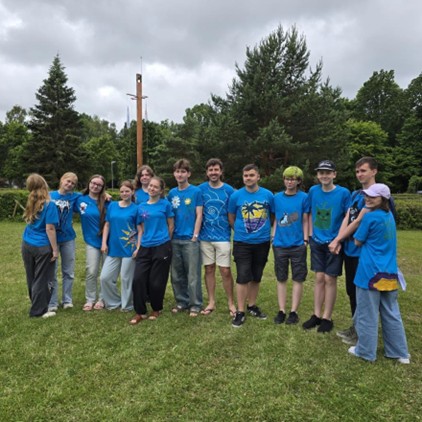

Why the camp mattered
The camp only lasted four days – but those four days held a lot: honest conversations, creative challenges, critical thinking, and concrete actions that could lead to real change.
The participants didn’t just talk about the problems, but also worked on solutions. Teenagers from two countries collaborated, learned from each other, and exchanged ideas that could transform not just their own experience online – but all of ours.
You can read more on the website of the Lithuanian Safer Internet Centre (draugiskasinternetas.lt) and the Latvian Safer Internet Centre (drossinternets.lv).
Find more information about the work of the Lithuanian and the Latvian Safer Internet Centres, including their awareness raising, helpline, hotline, and youth participation services, or find similar information for other Safer Internet Centres throughout Europe.
Young people from Lithuania and Latvia came together to rethink how we live online. Guided by media experts, NGO representatives, and facilitators from Langas į ateitį (part of SIC Lithuania), they created educational games, social media campaigns, and shared their vision for a healthier internet.

The camp left a very positive impression on the participants – some are already asking whether it will be held again next year. The positive experience was shaped not only by meaningful activities, but also by a consciously nurtured balance: some workshops took place on the beach, and after a full day, participants spent time in nature, surrounded by forest.
What are teenagers really doing online?
The camp kicked off by exploring what teenagers themselves brought to the table. Before arriving, each participant had completed a homework assignment: to reflect on their digital life – the words they use, the trends they follow, the tone they adopt.
One teenager from Lithuania opened up about how racist content still circulates in his friend group – and how deeply it affects them, especially when it comes from people close to him. The Latvian group introduced “tone indicators”: tools used to express emotional tone in writing and help reduce misunderstandings online.


Homework presentations at the camp.
Creative sprint led by Arminas Varanauskas
Day two was dedicated to a full-day creative challenge led by youth media expert Arminas Varanauskas. Participants designed a fictional peer – a user persona – and explored a real digital issue, like misleading links. They then brainstormed solutions that could be implemented right away. Some teams developed social media campaigns, while others created toolkits and ideas for schools. One thing became clear: young people have more solutions than we often give them credit for.


Creative sprint activities with Arminas Varanauskas.
Two teams, two creative tracks
Later on the same day, participants split into two working groups. One team focused on creating a Q&A resource about the digital world – covering everything from algorithms and screen time to how social media affects one’s behaviour and emotions. The second team collaborated with project leader Liudas Mikalkevičius to enhance an educational game he developed for schools – designed to teach students about safer internet habits, how to spot deepfakes, and how algorithms really work.

Talking about what usually gets left out
The day ended with a discussion session that led into a screening of the documentary Can’t Feel Nothing which explores the emotional toll of the digital age, by David Borenstein. The conversation was moderated by Dominyka Vaičiūnaitė, Draugiškas Internetas content creator.
Participants didn’t just reflect on how social media affected us in the past – they examined how it continues to shape lives today. Is it still worth having these conversations? Or are we too tired of talking about change that never really happens? Participants imagined what the world might look like in ten years if nothing changes – if we continue on the same path of endless scrolling and passive engagement.
The teenagers shared personal experiences of screen addiction, difficulty focusing, and the strange tension of social media being both a comfort and a source of stress.
They envisioned what their ideal social networks would look like – spaces with less pressure, more authenticity, and a true sense of community.
Langas į ateitį: art that speaks louder than words
One afternoon, a creative session was led by representative of Langas į ateitį Violeta Čiuplytė Bogdanovič. Together with the participants, everyone painted on t-shirts and stones, combining images and ideas about how the internet could become a safer, warmer space. It was one of those rare moments when words weren’t needed – everything the participants wanted to express came through in color and form.
This hands-on activity brought together three core elements of the camp: offline, face-to-face connection, open reflection on the challenges young people face online, and creative thinking toward a safer digital environment.


Why the camp mattered
The camp only lasted four days – but those four days held a lot: honest conversations, creative challenges, critical thinking, and concrete actions that could lead to real change.
The participants didn’t just talk about the problems, but also worked on solutions. Teenagers from two countries collaborated, learned from each other, and exchanged ideas that could transform not just their own experience online – but all of ours.
You can read more on the website of the Lithuanian Safer Internet Centre (draugiskasinternetas.lt) and the Latvian Safer Internet Centre (drossinternets.lv).
Find more information about the work of the Lithuanian and the Latvian Safer Internet Centres, including their awareness raising, helpline, hotline, and youth participation services, or find similar information for other Safer Internet Centres throughout Europe.
- < Previous article
- Next article >












